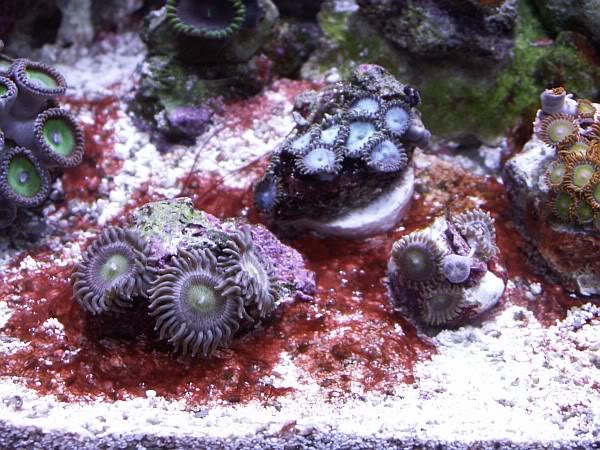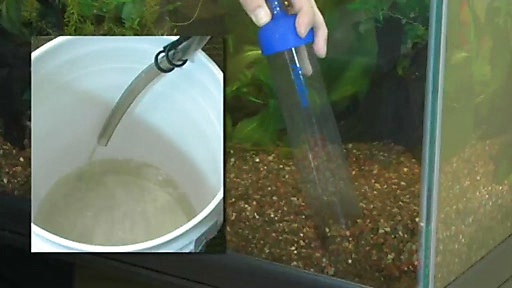CYANORRA SUCKER: Getting Rid Of Cyanobacteria Algae
Cyanobacteria is said to be responsible for the end of Oxygen intolerant life forms on the planet Earth. Before our atmosphere was extremely low on Oxygen. The Bacteria is photosynthetic, which means it turns light into energy, making Oxygen as a biproduct. After the Cyanobacterias first Earthly epidemic the composition of our atmosphere transformed into the Oxygen rich air we know today. Today’s plants are even thought to have evolved from early forms of Cyanobacteria.
This photosynthetic life form can live literally anywhere that has any amount of moisture present, the ocean, the lake, a pond, moist concrete, and even on glaciers! Cyanobacteria is also found in our aquariums. The kinds we see in the tank are usually black, blue, green, or red and look like slime. It can spread over corals, rocks, clams, and even turbo snails can get covered by it. We do not want that now do we?

cyanobacteria algae settled in around some coral frags – image via reef2reef member Murfman
Remember, if there is water present, cyanobacteria can form. The best way to avoid the most successful unicellular organism is not a quick answer. There are many causes for blooms to occur and many ways to prevent them.
LIGHTING
Cyanobacteria is photosynthetic, like corals, but thrives under a different spectrum and intensity. Check your bulbs, if they are old then change them out. Cyanobacteria often occurs under Lights that have lost their original color. Too much or too little lighting will also make it reproduce like crazy.
Turning off lights for 3 days can quickly clear a tank of Cyanobacteria, but you will still need to seek the source of the bloom.
FLOW
Cyanobacteria is slimy and will blow off the sand or rock with enough flow. In slower areas there is more settling of detritus and it will also cause cyanobacteria to accumulate and spread from their. Wave motions really help reduce detritus. Make sure there are no dead spots, if you have to you can put a small powerhead behind the rockwork to move the water.
If your tank is full of Cyanobacteria do not try to blast it off the rocks with a powerhead, instead try to siphon it out into a bucket to dispose of or even down into your sump into a filter sock if you really do not want to do a water change at that time…although you probably should.

image via petco.com
NUTRIENT LEVELS
How many cubes of food do you feed? Often times we will feed way more than the fish actually eat, and if they do eat it they still have that much waste. Are you dosing excess supplements? Sometimes we miscalculate how many gallons of water are actually in our tanks due to displacement from the rocks. Even if you first measure the exact amount, after so long your corals can grow large enough to mess with the water volume. A 3 foot anemone can easily displace quite a bit of water! Try reducing, or under dosing your water.
PARAMETERS
High nitrates and phosphates can lead to Cyanobacterial blooms. Reduction can be as simple as a water change or you can use various chemicals or media. There are various sponges and media packs that absorb phosphates and nitrates. Do not rely on these, for it is much better to reduce the Cyanobacteria and then figure out the source. One thing to understand is with the presence of this bacteria comes the masking of such levels.
If you see a large patch of Cyano or algae then you have to assume it is absorbing these chemicals. If you are getting readings for nitrates and phosphates AND you have Cyano then prepare for an immediate bloom.
REDUCTION/REMOVAL
To keep the corals from getting smothered it is best to keep good flow on them. A Duncan coral can easily be a bleached out branch after a few too many days covered in algae. Sometimes manually brushing off the corals is necessary. Getting it off the sand and rocks is also important to keep the beneficial things alive.
DO NOT try to clean up the slime by blasting it with a powerhead, for that just relocates the bacteria. The best thing to possibly do is:
- Stop feeding and Black out the tank for 3 days (besides any animals that require daily food, just limit feeding to them
- Prepare a large amount of salt water, between 50%-75% at equal temp and pH. This is going to replace the nasty water that is feeding your Cyano.
- With a thin siphon hose, siphon out as much Cyanobacteria, algae, or Diatoms you can possibly reach. Stop the hose when you are not near any slime to use the most of your time. I start at the top of the rocks and work down to go with the water level, poking into crevasses, caves, and even cleaning some snail shells. Be careful not to suck any corals up, as they have delicate flesh. Once you are confident you have cleaned every speck you could find, drain the tank to the amount you are going to replace.
- Replace the water.
- Leave the lights off for 2 more days
- Turn on the normal lighting schedule and observe (if any) the regrowth of the Cyano. IF it seems to have stopped Great, otherwise it is time to investigate.
- Feed your fish because they are probably hungry, but not a lot. Make sure they are eating and not missing a lot. Some people will pour 5 cubes of frozen and let the fish go nuts, but without proper filtration (ATS) this can easily result in cyanobacteria.
- Investigate. What is your tank doing wrong? Be honest with yourself. If you are under Skimming, Over feeding, Lacking of Water Changes, or having of too many fish you need to come to terms with that. It is OK because any problem can be fixed with understanding.
- Old Rocks
- Rotten Sand
- Slow Flow
- Low Light
- Old or wrong Spectrum Bulbs
- Too much Light
- Too much food
- Too many fish
- Inefficient Filtration
- Too large or small of a Clean up Crew
- Unknown dead animal
- Dosing too much or unneeded substances?
- Aeration not quiet high enough?
- RO water? Old filters or using tap?
- Nearby Cleaning. Air fresheners and cleaners in the air can exchange into the water column just as easily as Oxygen. Something as simple as a candle or incense nearby to cover up the fish tank smell could in fact be the cause of making it worse. Soap on your hands could contaminate the water as well as lotion, perfumes, and even after rubbing certain plants that emit odors both good or bad.
The most successful life form on the entire planet is a tough cookie to bake, but with the right recipe and the correct oven you can overcome this slime like Martha Stewart. We know her tanks are SPOTLESS! Some times it may take a while to pinpoint the exact cause of your specific bacteria. Do not give up until it is gone!
There is a very interesting way to have a slime free Display tank. The concept is to centralize the slime into its own separate environment where it actually can become of use, removing all the nasty from the water and creating a new environment for alternate life forms that you normally would not see.
Algae Scrubbers are one of the most efficient means of filtration not on the market when designed correctly. Check out these discussions on various Scrubbers if you are not familiar with them.
http://www.reef2reef.com/forums/reef-aquarium-discussion/124111-red-slime-cyanobactoeria.html
http://www.reef2reef.com/forums/reef-chemistry-forum/120935-need-help-algae-cyanobacteria.html
This is my experiment with Cyanobacteria: http://www.reef2reef.com/forums/reef-aquarium-discussion/124445-my-self-induced-cyanobacterial-bloom.html
Chemicals should always be lower on the list of considerations, but are very effective. Some can cure problems instantly, but cause others as a result. They can kill beneficial bacteria along with the stuff you want to remove, thus causing another cycle and potentially harming livestock during the new mini cycle. Check out some of the dry good sponsors for an assortment of treatments but make sure to research the effects of each one and make sure you have the means to use such treatments. No matter what direction you choose you must always have patience, as nothing in a reef tank happens at Ludicrous Speed!
